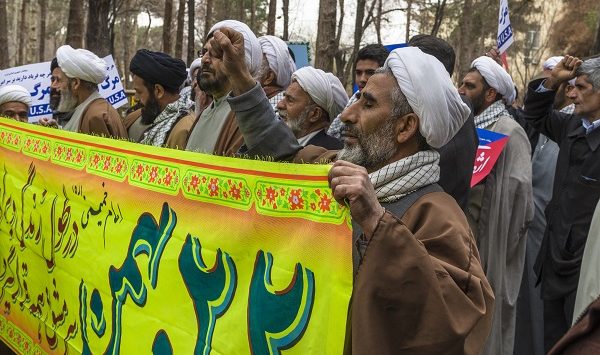The views and opinions expressed in this issue brief are those of the authors and do not necessarily reflect the official policy of GPI.
Issue Briefs

What is really happening in Iran?
Fazle Chowdhury
January 2, 2018
“Those who damage public property, disrupt order and break the law must be responsible for their behavior and pay the price,” stated Abdolreza Rahmani-Fazli, Iran’s Interior Minister. “The spreading of violence, fear and terror will definitely be confronted”, he continued. As Iran’s Interior Minister talks tough and promises to crack down on the protesters on the ground, one would like to understand why is the relatively moderate government of President Hasan Rouhani not listening to their grievances?
Economic hardships
Unlike the 2009 protests which were about the Iranian presidential election results, the current end of December 2017 protests are about lack of jobs, youth unemployment, rise in the cost of living, mostly basic goods becoming less affordable. A recent BBC Persian Service survey found that Iranians have become 15% poorer in the last 10 years. So, why hasn’t the Iranian President, his Ministers and the Iranian Supreme Leader –all of them aware of such potentially explosive issues– done anything to address them?
How bad is the Iranian economy?
Unlike most countries hit by sanctions, and compared to the overall business climate in the region, Iran has fared relatively well. In recent years it ranked 6th in attracting foreign investments (Tehran Times, January 23, 2012). That said, unofficial sources state that working conditions are amongst the bottom 25% in the World Labor Index.
With significant advances in science, technology and medicine, in the last two decades, university registration, specifically in Science and Technology (a cultural icon of Persia as the vanguard of Science and Mathematics education from centuries past), has gone up twenty times (Andy Coghlan. “Iran is top of the world in science growth”. New Scientist, retrieved 2 April 2016). This dramatic growth in enrollment however has not translated into a robust new work force, and therefore improved employment in these industrial sectors.
Before 2009, foreign investment had been relatively average. Some sectors like the oil and gas industries, vehicle manufacture, copper mining, petrochemicals, foods, pharmaceuticals and tourism were active. After Tehran signed the Joint Comprehensive Plan of Action with the world powers on July 2015 and implemented it in January 2016, things seemed to improve. One of the bigger companies to invest in Iran has been Nestle.
“When it comes to Iran, this country is, I would say, a special market for us, with considerable opportunities. We have here an 80 million population who have a lot of interest in premium-quality food. Iranians look for variety, which is what we can deliver,” Nestle’s Qazvin Factory Manager Faisal Haroon told Financial Tribune. A further $150M investment is projected in 2018.
Why investment hasn’t helped
But this is simply not enough to move the needle. New Foreign Direct Investment, FDI, is not flowing into Iran in the quantities necessary to make a real impact. “Navigating the country’s legal and regulatory regime is like walking in a minefield”, says Amir Paivar reporter with the BBC Persian Service.
Besides, corruption is a larger problem in Iran than most would like to admit. For instance, obtaining any form of permits without “extra payments” is nearly impossible, even for the relatively simple process of setting up any kind of business.
Sanctions were only a small part of the problem in Iran’s economy. Both formal trade and the most profitable black-market channels functioned relatively well because traders got used to the sanctions, and figured out ways to evade them.
The Revolutionary Guards control the economy
The real problem is a tightly controlled Iranian economy. “The extent of the Revolutionary Guards’ control over the Iranian economy is apparent, as soon as you enter the country”, says Julian Borger of The Guardian, (15 February, 2010). The joke amongst business people in Iran is that if you don’t factor in the Revolutionary Guards (IRGC) cut within your business model, your business will not fly. “The IRGC is really a corporation. It is a business conglomerate, with guns,” says Ali Ansari, an Iran expert at St. Andrews University.
Utilizing the frameworks of a Limited Liability Company (LLC) and independent contractors, the IRGC operates as the Iranian version of a Northrup Grumman, with no accountability and no controls. However, many of the beneficiaries are not owned directly by IRGC, rather the arrangement is a corp-to-corp setup, (a very dark method of hiding true owners and stakeholders).
When all is said and done, the IRGC is active in the construction business, oil and gas, import-export, and telecommunications. “If you want to get things to and from Iran without paying excise duty, they are the people to go to,” said Meir Javedanfar, an Iranian-Israeli analyst. “No big businessman in Iran is truly independent of them or the government,” Javedanfar observed.
The real reason
Though these peaceful protests in several cities in Iran erupted mostly because of economic reasons, there is a political side to them as well. Since 2011 Iranians have seen their government taking an active military role in Iraq, Syria and Yemen. The Ayatollahs have committed large resources abroad, rather than addressing the more pressing economic problems at home.
This was clearly illustrated in the chanted slogans during the recent demonstrations in Tehran “Leave Syria, think about us”. According to the United Nations envoy to Syria, Staffan de Mistura, the Iranian government spends at least $6 billion annually just on propping up Assad’s government in Damascus.
Larger message
The larger message of the demonstrations however is to Ayatollah Khamenei. He should pay attention to the future challenges faced by the University youth and to the severe hardships confronting the average Iranians who at a very basic level are suffering economically and cannot provide for their families.
Realistically, forces like that of the Basij militia force have the military means to suppress these protests in what possibly would be the most barbaric repression since the Arab Spring uprisings of 2011.
Think of how the Shah regime ended
But the seeds of discontent have been growing now for a very long time. To take no notice of this profound discontent would be unwise for the sole reason that the beginning of the chain of events that led to the overthrow of the Shah of Iran and his Savvak in January 1979 was not that different from what we are seeing today in several Iranian cities.
 Fazle Chowdhury is a Global Policy Institute Fellow and Professor at BAU International University. He is a Management Consultant and founder of FazC – a Public Speaking firm specializing in Conflict Economics. Mr. Chowdhury‘s experiences include monitoring terrorism finance, developing effective financially strategic battle plans to strengthen client organization’s incidents and consulting with the US Department of Defense. His previous engagements include United Nations Development Program (UNDP) – Azerbaijan, Booz Allen Hamilton, IBM, and Price Waterhouse Coopers. Mr.Chowdhury received his Master of Science in Organization Management from Northeastern University and has also completed the Executive Program & Stewardship in Management from Harvard University’s Kennedy School of Education.
Fazle Chowdhury is a Global Policy Institute Fellow and Professor at BAU International University. He is a Management Consultant and founder of FazC – a Public Speaking firm specializing in Conflict Economics. Mr. Chowdhury‘s experiences include monitoring terrorism finance, developing effective financially strategic battle plans to strengthen client organization’s incidents and consulting with the US Department of Defense. His previous engagements include United Nations Development Program (UNDP) – Azerbaijan, Booz Allen Hamilton, IBM, and Price Waterhouse Coopers. Mr.Chowdhury received his Master of Science in Organization Management from Northeastern University and has also completed the Executive Program & Stewardship in Management from Harvard University’s Kennedy School of Education.